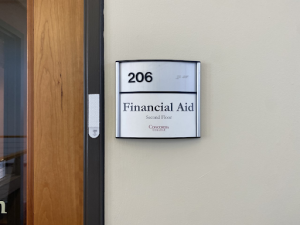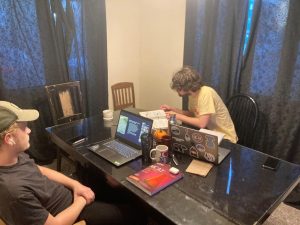Until three weeks ago, most college students had no idea what Zoom was. Now, in the wake of COVID-19, many college students are using the video conferencing website to finish their semesters online.
Concordia College started online learning on March 23, at first with the intent to come back to campus on April 13, but online classes were extended through the end of the semester to continue to keep students safe and slow the spread of COVID-19. Professors had about a week to figure out how to teach their classes online, and nearly a month in, students and professors alike are still adjusting to distance learning.
Students in all majors are figuring out how to stay on task in a new environment, without the usual structure of classes on campus.
“I try to do stuff outside and not use my bed as a workspace,” said Elle Olson, a pre-professional studio art major. Getting up and going somewhere to do has helped her stay focused on classes while away from campus.
Learning to focus in a new environment, lack of schedule and sharing a space with family members or roommates are just some of the challenges that students are facing. At Concordia, where personal connection and face-to-face learning is a selling point for prospective students, it is not ideal for any class to make the switch to being taught online, but some classes transfer to online instruction better than others.
For students in disciplines where hands on learning is essential to their success, like art, music and the sciences, the shift to online classes was complex. In a short time, professors had to figure out how students at home could get the same experiences as they would in a studio, lab or music room.
Art students rely on time in the studio to make art, experiment with new materials and techniques and bounce ideas off their peers. At home, most students don’t have the same tools as they would at school, and feedback from peers and professors on their work is not as immediate or personal.
Professors in some art classes, like the printmaking and sculpture classes that Olson is taking, constructed kits with materials for their students to take home and have created assignments around these kits for students to complete. This allows students to make art while also making sure each student has access to the same type of materials and tools.
Other classes, like ceramics, require students to work with clay and fire their pieces in a kiln, which is impossible when students cannot be in the studio. Classes like this have instead become more video and discussion based, so students can continue learning about ceramics even when they aren’t able to learn hands-on.
Science lab classes have also had to change their curriculum to accommodate students not being able to physically do the labs themselves. Rachel Friberg, majoring in nursing, is in an anatomy lab class and her first nursing clinical class, where students learn basic nursing skills such as how to roll patients in bed and take vital signs. Usually the nursing class would have frequent check-offs to ensure students are learning the basics of nursing, but now, students are watching videos and reading to learn about the skills, and will be tested in the fall when students return to campus.
Her anatomy lab is similar. The class watches videos and reads about the different things they would be doing in the lab, but Friberg feels that without actually being able to dissect animals or work with cadavers, they are missing out on valuable experiences in the lab.
“Labs have two parts, the part where you get information, like a packet from the professor, but there is also the part where you do an experiment or show a skill, and I feel like we don’t really get that,” she said.
For music students, especially music education students, learning in the music room is important. Music education majors take methods classes where they learn how to play different instruments so that they can teach those instruments, and learning from afar is not ideal. Lessons and participating in ensembles is also important to their learning. The move to online learning has also challenged music faculty with how exactly to give grades, as students are graded on juries and final performances at the end of the semester, but now will not be able to perform and get feedback from music faculty in person.
“In theory, your grade is what you do in performance, but half of the groups didn’t get to have a performance,” said David Eyler, professor and director of Percussion Ensemble and Marimba Choir.
Eyler has moved his lessons, ensembles and methods classes to Zoom. Students in his lessons and ensembles were sent home with a few instruments like a tambourine and a practice pad, so they can still work on learning about rhythm and musicality, and his methods classes meet on Zoom and watch videos on YouTube to get a better understanding of the techniques they are trying to learn.
Eyler’s sentiment about distance learning is one shared by many students and professors.
“We would like to be together but we are making the best out of the situation,” he said.
Annie is a senior double-majoring in Environmental Studies and Heritage and Museum Studies, as well as minoring in German. She loves adventures, coffee, and dogs. This is her third year with the Concordian.






[…] Music education majors take methods classes where they learn how to play different instruments so that they can teach those instruments, and learning … Date and Time of Source Publish: 2020-04-16 13:07:30 Read More at the Original Source […]